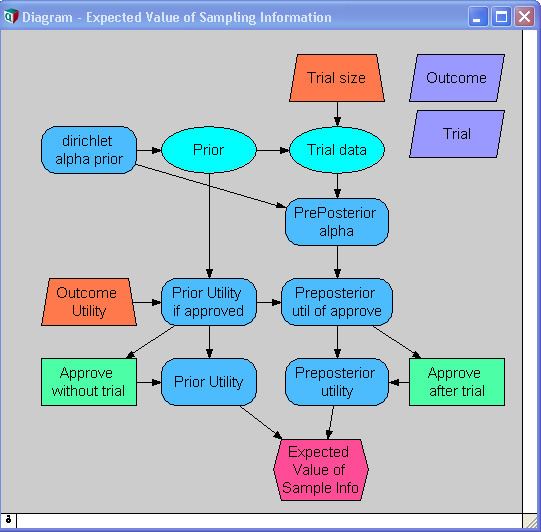 | ||
In decision theory, the expected value of sample information (EVSI) is the expected increase in utility that a decision-maker could obtain from gaining access to a sample of additional observations before making a decision. The additional information obtained from the sample may allow them to make a more informed, and thus better, decision, thus resulting in an increase in expected utility. EVSI attempts to estimate what this improvement would be before seeing actual sample data; hence, EVSI is a form of what is known as preposterior analysis.
Contents
Formulation
Let
It is common (but not essential) in EVSI scenarios for
The utility from the optimal decision based only on the prior, without making any further observations, is given by
If the decision-maker could gain access to a single sample,
where
Since they don't know what sample would actually be obtained if one were obtained, they must average over all possible samples to obtain the expected utility given a sample:
The expected value of sample information is then defined as
Computation
It is seldom feasible to carry out the integration over the space of possible observations in E[U|SI] analytically, so the computation of EVSI usually requires a Monte Carlo simulation. The method involves randomly simulating a sample,
Example
A regulatory agency is to decide whether to approve a new treatment. Before making the final approve/reject decision, they ask what the value would be of conducting a further trial study on
The diagram shows an influence diagram depiction of an Analytica model for computing the EVSI in this example. For the reader who wishes to study this computation in greater detail, the model can be viewed and evaluated from Analytica Web Player.
The model classifies the outcome for any given subject into one of five categories:
And for each of these outcomes, assigns a utility equal to an estimated patient-equivalent monetary value of the outcome.
A decision state,
The prior,
In the chance variable Trial data, trial data is simulated as a Monte Carlo sample from a Multinomial distribution. For example, when Trial_size=100, each Monte Carlo sample of Trial_data contains a vector that sums to 100 showing the number of subjects in the simulated study that experienced each of the five possible outcomes. The following result table depicts the first 8 simulated trial outcomes:
Combining this trial data with a Dirichlet prior requires only adding the outcome frequencies to the Dirichlet prior alpha values, resulting in a Diriclet posterior distribution for each simulated trial. For each of these, the decision to approve is made based on whether the mean utility is positive, and using a utility of zero when the treatment is not approved, the Pre-posterior utility is obtained. Repeating the computation for a range of possible trial sizes, an EVSI is obtained at each possible candidate trial size as depicted in this graph:
Historical background
The 1961 book Applied Statistical Decision Theory by Schlaifer and Raiffa was among the earliest to utilize EVSI extensively.
Comparison to related measures
Expected value of sample information (EVSI) is a relaxation of the expected value of perfect information (EVPI) metric, which encodes the increase of utility that would be obtained if one were to learn the true underlying state,
The expected value of including uncertainty (EVIU) compares the value of modeling uncertain information as compared to modeling a situation without taking uncertainty into account. Since the impact of uncertainty on computed results is often analysed using Monte Carlo methods, EVIU appears to be very similar to the value of carrying out an analysis using a Monte Carlo sample, which closely resembles in statement the notion captured with EVSI. However, EVSI and EVIU are quite distinct—a notable difference between the manner in which EVSI uses Bayesian updating to incorporate the simulated sample.
